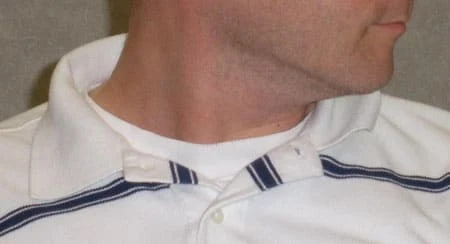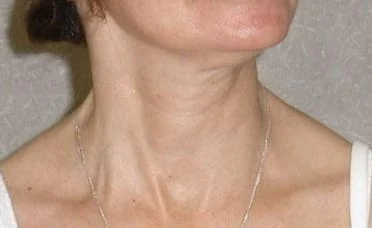Definition: Acquired torticollis (cervical dystonia) is a rare, typically idiopathic, brain disorder causing involuntary neck movements. Often associated with pain.
Patients may be able to relieve their symptoms by touching their neck, head, or face in a certain way (sensory trick).
Targeted intramuscular injection of botulinum toxin is the therapy with the best proven efficacy. Oral medications and physiotherapy may also have a role in the treatment of the condition.
Treatment options for refractory acquired torticollis include deep brain stimulation, radiofrequency ablation, selective surgical denervation, chemical denervation, and intrathecal baclofen.
Incidence
Although acquired torticollis is one of the most common forms of dystonia, it remains a rare disorder. Prevalence has been estimated at 1 in 10,000 to 20,000 people in the general population.[1] Incidence and prevalence are likely to be under-estimated in studies because of under-recognition of the condition.
In a retrospective study of a large health maintenance organization population in California, US from 1997 to 1999, 66 confirmed incident cases were identified in 8.6 million person-years of observation, leading to a minimum incidence of 0.8 per 100,000 person-years among people aged 30 years and older.
This study also found:
- Incidence was 2.5 times higher among women than men
- Mean age at diagnosis was 56 years among women and 45 years among men
- Patients had symptoms for an average of 4 to 5 years prior to confirmed diagnosis
- A disproportionate number of cases occurred among patients of white ancestry.
A study of the same population from 2003 to 2007 identified 200 incident cases, equivalent to an incidence of 1.18/100,000 person-years from 2003 to 2007.
A population-based study in Italy found 44.8 cases per 1 million persons. This may be a low estimate, as this was based upon diagnoses reported in the healthcare system.
Clinical picture (Diagnosis approach)
Acquired cervical dystonia is diagnosed clinically, but appropriate treatment is often delayed due to a lack of clinical recognition.
The key to diagnosis is an appropriate clinical suspicion for the disorder, coupled with a sensitive history and physical examination.
History
The presentation of a patient may include the following features:
- Involuntary twisting or deviation of the neck: may be verbalized as a cramp or spasm in the neck, shoulder, or upper back
- Pain: present to some degree in most cases, may be the chief presenting complaint, and severe enough to be a source of disability in a significant minority of cases.
- Head tremor: may also be the chief complaint.
- Insidious onset of symptoms: a sudden onset of symptoms would raise suspicion of a secondary acquired torticollis, or another disorder entirely.
- Ability to identify a primary direction for involuntary head movement; for example, twisting to the left and tilting backwards.
- Chiropractic intervention: many patients initially seek this.
 |
| Patient with severe left torticollis (note hypertrophy of right sternocleidomastoid muscle) |
 |
| Patient with moderate left torticollis or neck rotation, mild right laterocollis or lateral neck flexion, and mild retrocollis or neck extension |
An important alleviating factor is the presence of a sensory trick (geste antagoniste), defined as a movement the patient performs (usually to touch himself or herself in some way) that can ameliorate the involuntary movement and pain.
Sensory tricks usually involve bringing the hand to the face
The trick generally must be performed by the patient (as opposed to examiner) to be effective and can sometimes be effective even before the hand reaches the face
In some cases, just thinking about the sensory trick can provide relief
There is no significant association between direction of primary dystonic posture and laterality of hand used to perform the sensory trick. Other sensory tricks include resting the back of the head or neck on an object.
The absence of a sensory trick by no means rules out the diagnosis, but its presence greatly increases the likelihood of diagnosis, as this is a common and specific feature.
Most cases of acquired torticollis are idiopathic. However, certain factors have a weak association with the diagnosis, including a positive family history, trauma, and a history of the use of dopamine-blocking drugs.
In order to identify the possible risk factors, suggested lines of enquiry for the practitioner in the history-taking process include:
|
Physical examination
- Having patients walk or asking them to perform rapid alternating movements with their hands
- Asking patients to close their eyes.
- A typically asymmetrical pattern
- Irregularity or jerky quality.
- Examination of the neck includes:
- Palpation of neck musculature: may reveal hypertrophy of muscles involved in the dystonic posture. Focal tenderness is unusual and would raise suspicion of an alternative aetiology.
- Passive range of motion (ROM) in the neck: should be normal in early and mild cases.
- Mentation
- Cranial nerves
- Strength and tone in the neck and all extremities
- Sensation
- Reflexes
- Co-ordination
- Gait.
Further investigations
In typical cases, no further work-up beyond a history and physical examination is indicated, as ancillary studies are almost always normal.
- If the presentation is atypical, or additional abnormalities are discovered on neurological examination, computed tomography (CT) or magnetic resonance imaging (MRI) of the brain and/or neck (depending on abnormalities discovered) may be indicated.
- If cervical injury is suspected, testing for ROM is deferred and appropriate immobilisation established.
- A CT or MRI of the neck should be considered in patients with prominent pain complaints, reduced ROM of the neck, a visible or palpable mass, severe focal tenderness, or radiculopathy
- Electrophysiological studies, such as electromyography, are not typically indicated. However, they may be useful in guiding treatment with botulinum toxin
- Laboratory tests are generally not necessary but may be indicated if alternative/secondary diagnoses are being considered (e.g., Wilson's disease, Huntington's disease). In patients under 30 years of age, genetic testing for primary torsion dystonia (DYT-1) and screening tests for Wilson's disease (serum copper, ceruloplasmin and urinary copper excretion) may be appropriate. The European Federation of Neurological Societies recommends DYT1 testing before 30 years of age for patients with primary dystonia with limb onset, and in those with an affected relative with early-onset dystonia. DYT6 testing is recommended in early-onset or familial cases with craniocervical dystonia or after exclusion of DYT1. Individuals with early-onset myoclonus should be tested for mutations in the DYT11 gene.
Consultation
A diagnosis of acquired torticollis should prompt referral to a specialist. Ideally, patients are referred to a movement disorders specialist.
Referral to a neurologist or physiatrist is also appropriate from the primary care setting.
If botulinum toxin injections or other interventions are being considered, a consultant with experience in the intervention of interest should be sought.
↚
Differential Diagnosis
- Arthritis of cervical spine
- Neck mass
- Cerebral mass, lesion or infarct
- Posterior fossa mass
- Retropharyngeal abscess
- Parkinsonian syndromes
- Huntington's disease
- Tic disorder
- Dopa-responsive dystonia
- Trochlear nerve palsy
- Primary torsion dystonia (DYT-1)
- Wilson's disease
- Psychogenic dystonia
Management approach
- Improved function (e.g., ability to turn head easily when driving)
- Relief of pain
- Enhanced quality of life.
- Reduction of psychological distress (through patient education about the condition, management of expectations related to treatment and treatment of accompanying anxiety or depression)
- Reduced social stigma.
Oral medications
- A small number of patients may achieve adequate relief with oral medicines alone and thereby avoid recurrent expensive and invasive therapy.
- In the clinical setting of a more widespread or generalised dystonia, administration of botulinum toxin to all affected muscles is impossible, so oral medicines are typically the basis of therapy.
- Limited efficacy, especially at tolerable dosing
- Central side effects (e.g., fatigue, confusion) that are usually dose limiting
- All agents should be started at low doses and increased to efficacy or until tolerability limits dose.
Physiotherapy
Botulinum toxin
- Botulinum toxin types A and B have been shown to provide significant benefit in placebo-controlled trials. Botulinum toxin has also been found to be significantly more beneficial than oral trihexyphenidyl.
- According to the American Academy of Neurology, abobotulinumtoxinA and rimabotulinumtoxinB are established effective treatments for cervical dystonia and should be offered, while onabotulinumtoxinA and incobotulinumtoxinA are probably effective and should be considered.
- Head-to-head randomised trials have compared botulinum toxin type A to botulinum toxin type B. No significant differences in efficacy have been demonstrated. Dry mouth was a more frequent adverse event with botulinum toxin type B.
- A Cochrane review found that a single botulinum toxin type A injection session led to improvement in cervical dystonia-related impairment and pain compared with placebo; however, data were insufficient to evaluate efficacy of repeated injections.
- A Cochrane review found no significant difference in efficacy of botulinum toxin type B versus type A; however, there was an increased risk of sore throat/dry mouth with type B.
- Although most evidence for the efficacy of botulinum toxin injections comes from trials of idiopathic isolated cervical dystonia, a small trial of cervical dystonia in people with cerebral palsy has shown similar efficacy.
- Botulinum toxin is injected into dystonic muscles and serves to block release of acetylcholine into the neuromuscular junction, resulting in partial chemical denervation.
- The clinical effect typically lasts 3 to 4 months.
- Injections are typically repeated every 3 to 4 months.
- Some clinicians advocate the use of electromyography to localise muscles for injection. This technique is particularly useful in injecting deep or small muscles. Limited evidence suggests that using electromyography guidance may improve outcomes.
- Ultrasound imaging is also sometimes used to guide injections.
- A Cochrane review found insufficient evidence to evaluate the benefits of electromyography guidance techniques.
